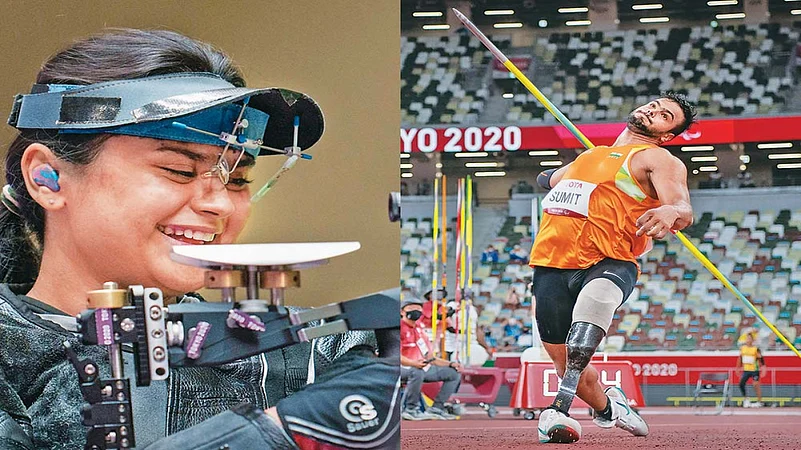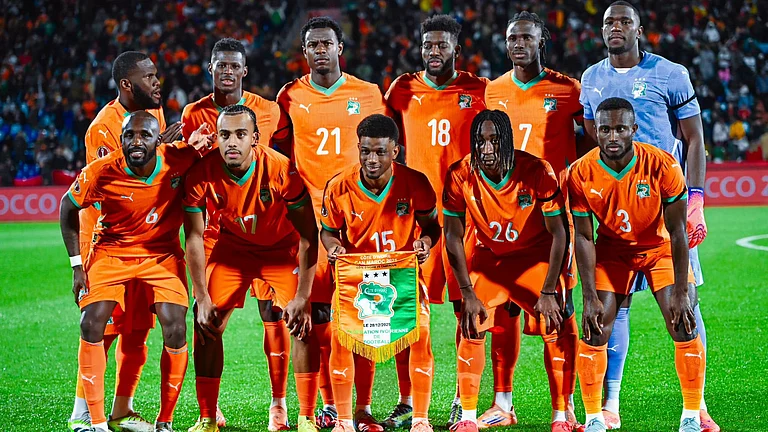If sports is about enshrining the qualities of leaping over barriers and pushing the body to its farthest limits with expert skill, no group embodies them more than para athletes. Not for nothing did Sachin Tendulkar call them “real-life heroes”. For someone who has amassed more than 34,000 international runs in a relatively injury-free career spanning 24 years, Tendulkar calling para athletes an extraordinary legion of sportspersons is not without reason. Each of the 4,403 athletes competing in the Tokyo 2020 Paralympic Games is special. Challenged physically in various degrees, the record turnout in Tokyo is a growing testament that nothing is impossible if the mind is without fear and the body is willing.
It is perhaps impossible to name the greatest sportsperson of all times. More so when specially challenged athletes are equal, or more than equal, to their able-bodied counterparts. Tendulkar may be a cricketing great by the sheer volume of runs scored or Michael Phelps the greatest Olympian with 28 medals over five Summer Games, but they were all able-bodied men up against a phalanx of athletes nearly as good. Then, how does one categorise Trischa Zorn, the American para swimmer who made her Paralympic debut in the Dutch city of Arnhem in 1980 and won her 55th medal at Athens 2004, remaining virtually unbeatable for three decades? Congenitally blind, Trischa had combated her disability every single day, in the process setting a benchmark for the likes of Phelps and Janet Evans to emulate. In modern times, perhaps the most outstanding Paralympian is Beatrice ‘Bebe’ Vio, the 24-year-old Italian wheelchair fencer who won her second straight Olympic gold medal at Tokyo 2020. When Bebe was 11, doctors had to amputate both her forearms and legs at the knee to save her from meningitis.

Ibrahim Hamadtou | Egypt
An inspirational athlete from Egypt, the 48-year-old has no arms and plays with his racquet clamped between his teeth. Ibrahim chips the ball into the air with his foot to serve. Hamadtou lost both his arms above the elbow in a train accident when he was just 10. Three years later, in 1986, he first took up table tennis. The 2013 Arab Athlete of the Year took part in Rio 2016. A Cristiano Ronaldo fan, Hamadtou is an internet sensation and is married with a son and two daughters. His personal philosophy: “Never give up in life!”
Photograph by AP
Fierce competitors who train hard and long, the aspiration levels of Paralympians are no less than able-bodied Olympians. And they are at the forefront now like no other Paralympics in the past, as if it took the fragility that the pandemic spawned for us to really value their contribution. These Games, according to Andrew Parsons, the International Paralympic Committee president, have helped smash stereotypes and demonstrate why persons with disabilities need to be active, visible, and contributing members of a global society now, more than ever.
Indeed, the stature of paralympians, and media awareness about their value have come a long way since when Harry Mosby’s achievement was barely noticed. Mosby had been one of the hundreds building railway lines in Western Australia. Then only 21, Mosby lost both his legs when they were crushed by a train carriage. Yet, when he returned to his island home off the tip of Cape York in Queensland a decade later, no one—not even his brothers—knew that during his time away, Mosby had represented Australia at the 1976 Toronto Paralympics, becoming the only Torres Strait Islander Paralympian, and won a silver.

Philip Coates-Palgrave | Zimbabwe
Coates-Palgrave is a Paralympic Games debutant and is competing in the men’s individual compound archery tournament. He was working as a canoe guide in Zimbabwe in 1995 when a hippo collided with his boat as it came up for air on the Zambezi River. The startled beast attacked immediately and seized Coates-Palgrave by his left leg while he strove to protect the tourists. He was dragged into the depths and mauled during a three-minute onslaught. Philip faced an agonising 25-hour trip to a hospital in Harare and underwent months of surgery before having his left leg amputated. He discovered archery in 2016 after following an impulse to take up a sport that could make him a Paralympian.
Photograph by IPC
In these days of a lightning fast digital world, when every medal is celebrated and rewarded handsomely, one can’t quite visualise the understated way in which para athletes went about their way. We don’t know a lot about the towering achievement of Murlikant Petkar, the first Indian to win gold at the Paralympics. A former soldier who was crippled after suffering several bullet wounds and then being crushed by a truck in a camp in Jammu and Kashmir in 1965, Petkar won gold in the 50m freestyle swimming at the 1972 Heidelberg Paralympic Games, clocking 37.33 seconds and setting a world record. Like many Armymen, Petkar was a boxer but after the tragedy, he switched to swimming and other sports. At the 1968 Paralympic Games in Tel Aviv, he participated in table tennis. He was awarded the Padma Shri in 2018.
In recent years, with the help of the Union sports ministry, India’s success rate at the Paralympic Games have improved considerably. In Tokyo 2020, India’s Paralympians have surpassed their best haul of four medals at Rio 2016. In 45 years of Paralympic shooting, India had not won a medal of any colour. A 19-year-old, Avani Lekhara, changed all that when the Jaipur girl equalled the world record in (R2) women’s 10m air rifle standing (SH1) to take gold. A car accident in 2012, when Avani was 11, had left her paralysed from waist down. Her father encouraged Avani to play a sport and after archery, she found her passion in shooting. Avani did not have to look far for inspiration. The Abhinav Bindra fan began shooting in 2015.

Omara Durand | Cuba
Cuba’s sprinting jewel knows that the eyes of the world will be on her as she defends the three Paralympic titles won in Rio. Visually-impaired, Durand’s decade of dominance includes gold medals in the 100m and 400m at London 2012. During the Covid lockdown, Durand was without her competition guide Yuniol Kindelan. She had to adapt to a training regime on her own. She dismisses the label of the ‘fastest female para athlete’. “I have had to live intense, exciting, sad, happy moments. In short, I think I have lived almost everything in sport and from the bad moments I have learned lessons that have helped me for life inside and outside of sport,” she says.
Photograph by AP
It was Bhavina Patel who started India’s medal haul in Tokyo. She won silver in para table tennis on India’s National Sports Day on August 29. For a woman coming from a sleepy village, Sundhiya, in Gujarat’s Mahesana district, Bhavina’s success is a fairytale laced with nothing but hard work and the will to excel. “I have set an example for people with disabilities that nothing is impossible,” said Bhavina, who had a point to prove to her detractors. Five years ago, bureaucracy had played a part in Bhavina missing the ticket to Rio. The blow had shattered her.

Haven Shepherd | US
When Haven Shepherd of the US was 14 months old, her parents strapped a bomb to themselves and held her in their arms in an attempted family suicide in Vietnam. Her mother and father were killed but Haven survived, with the injuries forcing both her legs to be amputated below the knee. She was adopted by Americans and taken to Carthage, Missouri. Haven made her Paralympic debut in Tokyo, where she competed in the women’s 100m breaststroke and the 200m individual medley. Calling herself a miracle child, Haven also competes in CrossFit and works as a model. She aims to inspire others in a world replete with emphasis on body image.
Tokyo and javelin have been synonymous for Indian athletes this year. After Neeraj Chopra won India’s first Olympic athletics gold, Sumit Antil clinched gold in the men’s javelin F64 at the Tokyo Paralympics, with a new world record throw of 68.55m. The 23-year-old, who lost his left leg in a motorbike accident in 2015, smashed the world record not once, or twice, but thrice during the final at the Olympic Stadium. “Currently, I’m unemployed...but I hope I will get a job after this. Let’s see what happens when I return to India,” he says. The Haryana government has promised him a job and Rs 6 crore for winning gold. Sumit’s performance overshadowed ace javelin thrower Devendra Jhajharia, who clinched silver. Jhajharia is India’s greatest Paralympian, after winning gold medals at the 2004 and 2016 Games. Sports loving Indians are waking up to the sound of their success, each preceded by personal tragedy, each medal bought by sacrifice and iron will.
(This appeared in the print edition as "Never Out On A Limb")
(With inputs from International Paralympic Committee)


























